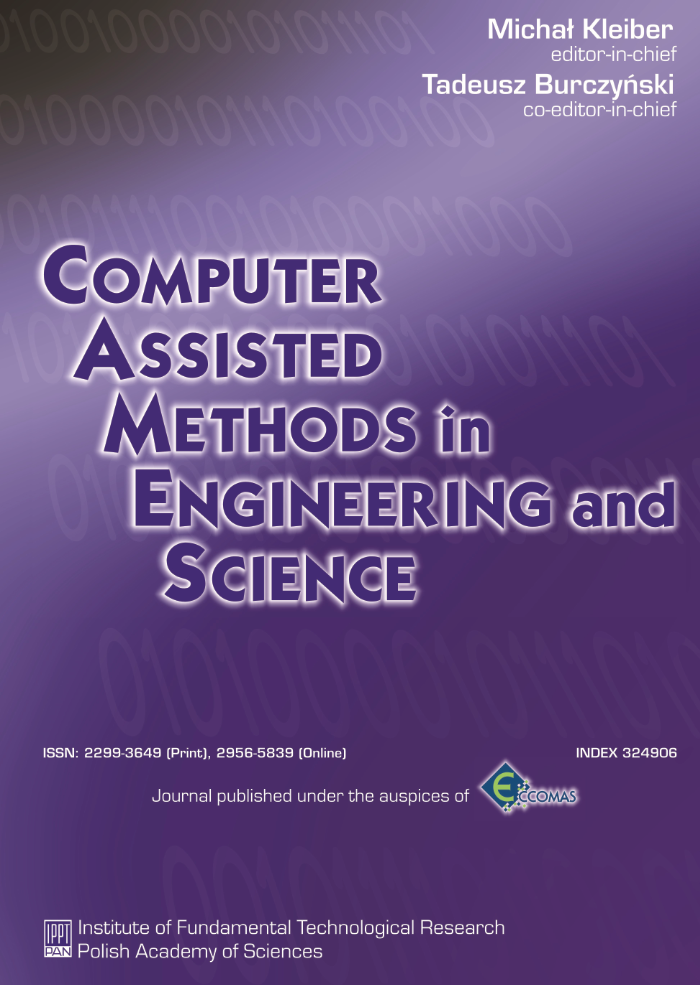Parametric Analysis of Damage in Cancellous Bone and in Materials with Bone-like Microstructure
Abstract
A systematic approach to the macroscopic damage analysis of bone-like cellular materials is presented in which damage conditions are expressed as tabularized functions of microstructure geometry parameters. Based on three different strain-based microscopic damage criteria, a large number of cellular microstructures, characterized by different values of geometric parameters, are analysed by the finite element method to determine damage factor values for a number of macroscopic strain states. As a result, an exhaustive database is prepared in which macroscopic damage conditions for a variety of microstructures are presented as tabularized parametric functions of both geometric parameters and strain states. A numerical procedure of data interpolation is proposed as a tool to predict parameterized damage surfaces for any bone-like microstructure. The results are made publicly available in an open data repository to enable further research on their characterization and analytical approximation.
Keywords:
cancellous bone, damage properties, parametric studies, finite element (FE) analysisReferences
1. H.H. Bayraktar, A. Gupta, R.Y. Kwon, P. Papadopoulos, T.M. Keaveny, The modified super-ellipsoid yield criterion for human trabecular bone, Journal of Biomechanical Engineering, 126: 677–684, 2004, https://doi.org/10.1115/1.1763177.
2. H.H. Bayraktar, E.F. Morgan, G.L. Niebur, G.E. Morris, E.K. Wong, T.M. Keaveny, Comparison of the elastic and yield properties of human femoral trabecular and cortical bone tissue, Journal of Biomechanics, 37: 27–35, 2004, https://doi.org/10.1016/S0021-9290(03)00257-4.
3. L. Colabella, A.P. Cisilino, G. Häiat, P. Kowalczyk, Mimetization of the elastic properties of cancellous bone via a parameterized cellular material, Biomechanics and Modeling in Mechanobiology, 16: 1485–1502, 2017, https://doi.org/10.1007/s10237-017-0901-y.
4. M. Frank, A.G. Reisinger, D.H. Pahr, P.J. Thurner, Effects of osteoporosis on bone morphometry and material properties of individual human trabeculae in the femoral head, JBMR Plus, 5(6): e10503, 2021, https://doi.org/10.1002/jbm4.10503.
5. N.M. Harrison, P. McDonnell, L. Mullins, N. Wilson, D. O’Mahoney, P.E. McHugh, Failure modelling of trabecular bone using a non-linear combined damage and fracture voxel finite element approach, Biomechanics and Modeling in Mechanobiology, 12: 225–241, 2013, https://doi.org/10.1007/s10237-012-0394-7.
6. J. Kabel, B. van Rietbergen, M. Dalstra, A. Odgaard, R. Huiskes, The role of an effective isotropic tissue modulus in the elastic properties of cancellous bone, Journal of Biomechanics, 32(7): 673–680, 1999, https://doi.org/10.1016/S0021-9290(99)00045-7.
7. J.H. Keyak, S.A. Rossi, Prediction of femoral fracture load using finite element models: An examination of stress- and strain-based failure theories, Journal of Biomechanics, 33(2): 209–214, 2000, https://doi.org/10.1016/S0021-9290(99)00152-9.
8. J.H. Keyak, Improved prediction of proximal femoral fracture load using nonlinear finite element models, Medical Engineering and Physics, 23(3): 165–173, 2001, https://doi.org/10.1016/S1350-4533(01)00045-5.
9. P. Kowalczyk, Elastic properties of cancellous bone derived from finite element models of parameterized microstructure cells, Journal of Biomechanics, 36(7): 961–972, 2003, https://doi.org/10.1016/S0021-9290(03)00065-4.
10. P. Kowalczyk, Orthotropic properties of cancellous bone modelled as parameterized cellular material, Computer Methods in Biomechanics and Biomedical Engineering, 9(3): 135–147, 2006, https://doi.org/10.1080/10255840600751473.
11. P. Kowalczyk, Parametric damage data of cellular bone-like microstructures, RepOD, 2025, https://doi.org/10.18150/4SOSUD.
12. R.K. Nalla, J.H. Kinney, R.O. Ritchie, Mechanistic fracture criteria for the failure of human cortical bone, Nature Materials, 2: 164–168, 2003, https://doi.org/10.1038/nmat832.
13. G. Niebur, M.J. Feldstein, J.C. Yuen, T.J. Chen, T.M. Keaveny, High-resolution finite element models with tissue strength symmetry accurately predict failure of trabecular bone, Journal of Biomechanics, 33: 1575–1583, 2000, https://doi.org/10.1016/S0021-9290(00)00149-4.
14. W. Pistoia, B. van Rietbergen, E.-M. Lochmüller, C.A. Hill, P. Rüegsegger, Estimation of distal radius failure load with micro-finite element analysis models based on three-dimensional peripheral quantitative computed tomography images, Bone, 30(6): 842–848,
2002, https://doi.org/10.1016/s8756-3282(02)00736-6.
15. E. Schileo, F. Taddei, L. Cristofolini, M. Viceconti, Subject-specific finite element models implementing a maximum principal strain criterion are able to estimate failure risk and fracture location on human femurs tested in vitro, Journal of Biomechanics, 41: 356–367, 2008, https://doi.org/10.1016/j.jbiomech.2007.09.009.
16. B. van Rietbergen, H. Weinans, R. Huiskes, A. Odgaard, A new method to determine trabecular bone elastic properties and loading using micromechanical finite-element models, Journal of Biomechanics, 28(1): 69–81, 1995, https://doi.org/10.1016/0021-9290(95)80008-5.







